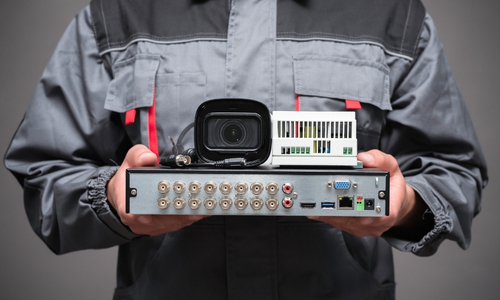Common Mistakes to Avoid During CCTV Camera Installation
When securing your home or business, CCTV cameras are a vital investment. However, the effectiveness of your system heavily depends on proper installation. Even with top-quality cameras, making some common mistakes during setup can undermine your security efforts. Whether you’re doing it yourself or hiring professionals, understanding what to avoid is key.
Understanding CCTV Installation Basics
Purpose of CCTV Systems
CCTV cameras monitor specific areas, detect suspicious activities, and serve as crucial evidence in case of a security breach. Ensuring they are placed correctly is critical to achieving effective coverage for your home, business, or outdoor spaces.
How Installation Affects Security
Proper setup ensures comprehensive monitoring and clear footage, while improper installation can lead to gaps in coverage, missed events, and poor-quality recordings.
Common Mistakes During CCTV Camera Installation
Incorrect Camera Placement
One of the most frequent mistakes is placing cameras in areas with blind spots. Key areas like entrances, exits, and high-traffic zones need adequate coverage to avoid missing crucial events. Additionally, many people overlook entry points such as windows and backdoors, which are prime targets for intruders.
Ignoring Lighting Conditions
Lighting plays a significant role in CCTV footage quality. Failing to consider lighting can lead to unclear or unusable footage. For example, cameras positioned directly in sunlight can produce glare, while poor night vision capabilities leave you vulnerable during nighttime.
Choosing the Wrong Camera Type
Indoor cameras should not be used outdoors. Outdoor cameras are designed to withstand harsh conditions, whereas indoor cameras can quickly fail when exposed to weather. It’s also important to decide between analog and IP cameras. IP cameras generally offer higher quality footage, better features, and easier integration into modern systems.
Overlooking Cable Management
Messy or exposed cables are not only unsightly but can also become damaged over time, leading to disruptions in functionality. Secure and conceal all wires to prevent accidents and ensure long-term reliability. Similarly, always check that power connections are stable—loose or unsecured power supplies can cause cameras to fail at critical moments.
Improper DVR/NVR Setup
Many people forget to ensure compatibility between their storage devices (like external hard drives) and the DVR or NVR system. Without adequate storage, your system might stop recording important footage. Another issue is poor network setup with IP systems, where bandwidth constraints can lead to lost or delayed footage.
Avoiding Connectivity Issues
Weak Wi-Fi Signal
Wireless cameras need a strong Wi-Fi connection. A weak signal can lead to buffering, video lag, or even disconnections. Make sure to test signal strength before finalizing installation and consider adding Wi-Fi boosters if needed.
Cybersecurity Neglect
In today’s connected world, securing your cameras from hacking is crucial. Change default passwords, enable encryption, and update the system’s firmware regularly to protect against unauthorized access.
Legal and Privacy Considerations
Respecting Privacy Laws
Installing CCTV cameras without considering privacy laws can get you into legal trouble. Make sure your cameras don’t point at neighbors’ properties or other private spaces, such as restrooms. Violating privacy laws can lead to fines or lawsuits, so it’s essential to be aware of regulations in your area.
Informing Others
If you’re setting up CCTV cameras in shared spaces, it’s important to inform others. Whether it’s a workplace or shared living environment, transparency about the presence of cameras is both legally necessary and promotes trust among occupants.
The Importance of Regular Maintenance
Cleaning the Lenses
Dust, dirt, and other debris can gather on camera lenses over time, affecting video clarity. Regularly cleaning the lenses ensures sharp, clear footage at all times.
Updating Firmware
CCTV systems receive periodic updates to improve performance and security. Be sure to check for firmware updates and apply them as necessary to keep your system optimized and secure.
Conclusion: Ensuring a Secure CCTV System
CCTV cameras are an essential tool for enhancing security, but improper installation can compromise their effectiveness. Avoiding mistakes like incorrect placement, neglecting lighting conditions, poor cable management, and failing to secure your system from cyber threats ensures you get the most out of your investment.
FAQs
1. Can I install indoor cameras outdoors?
No, indoor cameras are not built to handle outdoor elements like rain or extreme temperatures. Always use weatherproof outdoor cameras.
2. What’s the best way to avoid blind spots?
To avoid blind spots, map out your key areas (like entrances and exits) and test the camera’s field of view before finalizing placement.
3. How can I improve my wireless camera’s connection?
Ensure a strong Wi-Fi signal near your cameras, and consider adding a Wi-Fi extender if your signal is weak.
4. How often should I update my CCTV system’s firmware?
Check for firmware updates every few months or whenever you receive notifications from the manufacturer to keep your system secure.
5. What should I do if my camera footage is blurry at night?
If night vision footage is blurry, ensure there’s adequate lighting or invest in cameras with better infrared capabilities.




